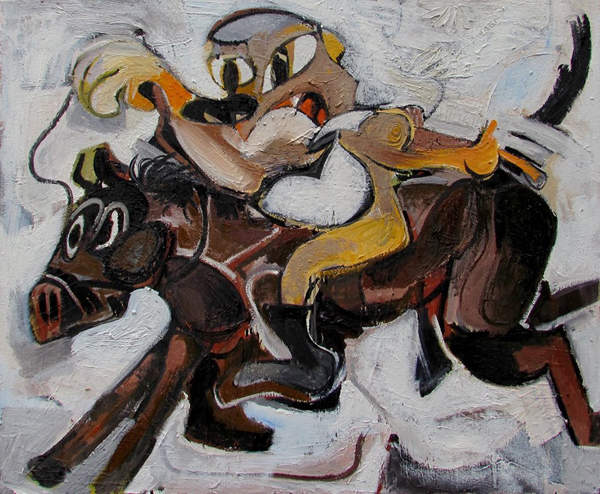With his solo-exhibition debut at the National Arts Club in New York City this past Wednesday, artist Kiki Valdes brought a much-needed dose of modernity to the Club’s hallowed Marquis gallery.
Kiki is bright-eyed, young, and energetic and his show is the symbolic gesture of a shift that has needed to happen at the club for some time – an appreciation for the new generation of artists that will carry the club into the future. Part of it is simply “doing business”, but most of it is simply preservation of the Club’s philosophy: to educate.
Kiki Valdes’ art is composed of a satisfying series of surprises and contrasts. He pairs classic environments with current popular culture. If that sounds exhausting and chaotic, the work is easy on the eyes by way of a subdued, earthy color scheme and is made extraordinarily approachable through its subject matter: the cartoon. Note this: upon first look, you might feel a sense of Picasso-tendencies (often considered a cultural faux-pas to emulate) however, the only real similarity to Picasso is limited to the color scheme, which occasionally feels unabashedly lifted out of a cubist work.
The composition of the works flirt with cubism and Picasso’s African-inspired period, but are fundamentally rooted in cartoon. But these are not airy, sketchy pieces that are dependent on a plot or opposing slides. Rather, the idea of a cartoon is completely dissected and re-imagined in Valdes’ work to accommodate his need for emotion. The brushstrokes are dark, demanding, and attractive, they drag your eye around the canvas, pushing and pulling.
Three things create the action in the work. First, you’re thrown to the ground as the subject is thrown to the ground by the clear sense of direction dictated by these strokes. Secondly, the dense shadows indicate a closeness and immediacy – should I step out of the way? Third, the composition is centered around where action will ultimately leave the subject. If the subject is on a horse in the work, the composition is built around the subject being on the ground.
Further, it is Valdes’ use of a classic but underused setting for his work: The American West. It is a place that is familiar and instantly recognizable, and Valdes’ distortion of it is perfectly situated between genuinely ‘western’ and barely there – this is because Valdes’ works often lack any sight-lines or horizons.
Maybe Valdes was the perfect choice to usher in this new moment for the National Arts Club. Who else could bridge the old and the new so well?
“Kiki Valdes: Riding Dualism” will be on view at The National Arts Club, New York from November 3-29.
-Benjamin Schmidt
